


Eliza Catherine Partleton (1829-1908)
Eliza Catherine Partleton, daughter of house painter Benjamin Thomas Partleton (1799-1843) and Mary Greenwood (1800-1855) was christened - along with her big brother William George Partleton - on 08 July 1829 at St-Mary-at-Lambeth Church:

The church of St Mary-at-Lambeth is on the opposite bank of the Thames to Westminster Hall, aka the Houses of Parliament, both buildings circled in blue in the map below:

St Mary-at-Lambeth Church has been a very popular subject for painters, which is great for us because it provides plenty of stuff to look at:
1825, from the west with the Thames and Lambeth Stairs in the foreground:

In the picture below, we are standing on the tower of St Mary's, looking across the Thames at the old Houses of Parliament and Westminster Abbey:

1836, from the east... this is the church as it appeared when baby Eliza was christened in 1829:
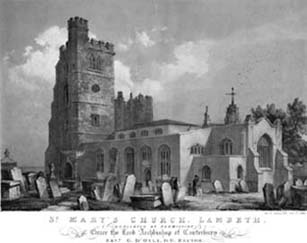
1851, also from the east; we see the results of a Victorian rebuild. Only the tower remains unchanged, as it still does today. In 1977 the church was deconsecrated and became the Museum of Garden History.

The most famous grave at St Mary-at-Lambeth is that of Captain William Bligh, of Mutiny on the Bounty fame, who died in 1817:

To get back to our Eliza, she's only a baby, but for the other members of the Partleton family who were present at the christening, we may step into their shoes as they exit the church because we have a nice painting of the row of houses opposite, on Church Road, (circled in red in the map above):

The yellow building is Bunyan's Hall, also a favourite subject for artists, with its wooden buttresses shoring it precariously from collapse:


The address given for Eliza's family on the christening register is Hampshire Street, a mile or so south of the church, which we see in the map below:

There are some notable landmarks in the vicinity of Eliza's birthplace. The first is a famous pub, The Horns Tavern (located in the red circle), situated directly opposite Kennington Park, formerly Kennington Common:
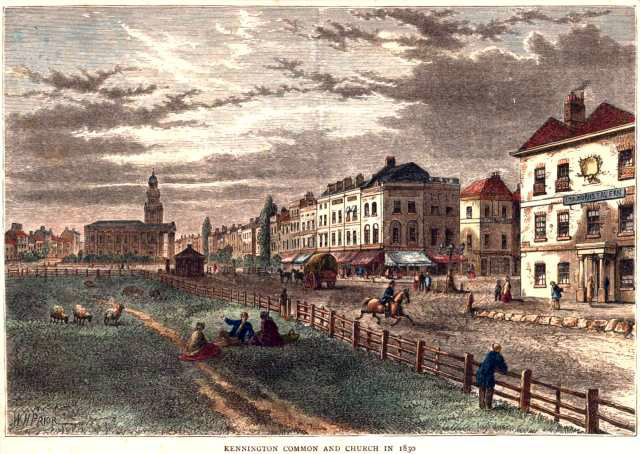

The picture above is just perfect. The year is 1830, just one year after Eliza's birth. The building on the right is the Horns Tavern. Turn right here, and a short walk along Upper Kennington Green through the back streets, we'll come to Hampshire Street and knock on Eliza's door. Sheep graze on the common, just a mile or two from the heart of London. In the distance we see St Mark's Church, circled on the map, and in the middle distance in front of the church we see the Kennington Turnpike (green circle, marked Kennington Gate).
If you wanted to take your coach south from Kennington, you had to pay a toll which went towards the cost of maintaining the road. The turnpike toll house was strategically located at the junction of the two major roads south. In the 1860 picture below we are looking south-west and we see a coach entering London from the Chichester Road. Next to the picture we see an actual ticket preserved from 21 March 1725.


So this is the area in which our Eliza grew up. In the 1841 census we see her aged 12 at home with the family at 8 Francis Street, which is right next to Hampshire Street in the map above.

Eliza's dad, Benjamin Thomas Partleton (1799-1843) was a house painter by trade. Although his family were of modest means, Benjamin had grown up in the parish of St James, north of the river - really a posh part of London as it still is today. Some of his brothers and sisters were actors and extras in the London theatres. By the time Benjamin married Mary Greenwood in 1822, he has moved to Lambeth, definitely a bad indicator as this is a much poorer part of the city.
Through the 1800s, conditions in Lambeth worsen as soaring overpopulation occurs and living conditions deteriorate.
And so it is in this context that 18 months after the above census we witness the death of Benjamin Partleton in 1843 of a stroke, certificate courtesy of Terry Partleton:

Poor Eliza is just 13 years old as her dad dies. In a letter of 20 January 1843, a friend of Eliza's uncle George (a travelling actor), a man by the name of Henry Hartley, wrote: "George Partleton lost his [brother] last week leaving a wife and seven children."
The implications behind this statement are plain. This is a total, irrecoverable catastrophe for the family. Eliza's mum Mary has no means of supporting her children. What must happen now is that those who are old enough must go out to work, and for the others where possible to be taken in by uncles and aunts. There is one other alternative... the dreaded workhouse, which - as far as I can tell - the family managed to avoid.
We don't know what happened to Eliza immediately after her father's death; the next we see of her is 8 years later in the census of 1851:
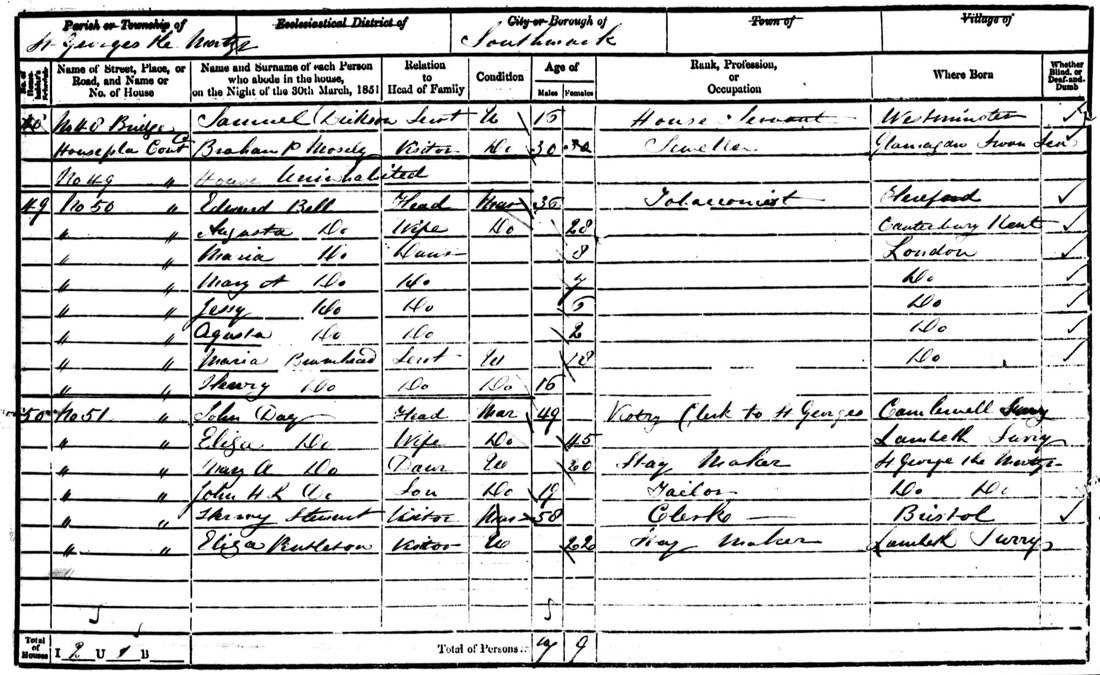
Eliza is a visitor at the residence of John Day, 'Clerk to St Georges'. 'St Georges' is the church of St George the Martyr in Southwark. Why is Eliza a visitor in this house? Perhaps the clue is that her occupation is given as 'Stay Maker', which happens to be the same as that of John Day's daughter May Day [crazy name]. Perhaps these two girls are friends. 'Stays' are the stiffeners in corsets, usually made of bone.
So, let's check out the neighbourhood. John Day's house is just a little north of the Elephant & Castle. It's in Bridge House Place which is at the south end of Blackman Street in the map below:
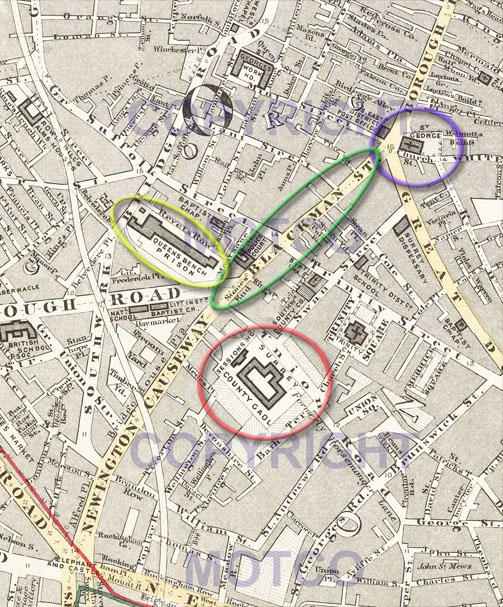
You know, the internet is an amazing place. I searched for Blackman Street with very little expectation of finding anything at all, but soon enough found this stunning painting by artist John Atkinson Grimshaw (1836-1893):

I'm sure you'll agree that you could veritably put your foot through the screen and have a walk around for five minutes in Victorian London. Check out the sky, green and pink, and the welcoming amber glow of the shop fronts. In the background we see the church of St George the Martyr. In the foreground we see people gazing into shop windows on Blackman Street. Step into Eliza's shoes.
Below we see a photo of the artist John Grimshaw and another wonderful rainy smoggy 'pea soup' view of Blackman Street with St George the Martyr glowering in the background.
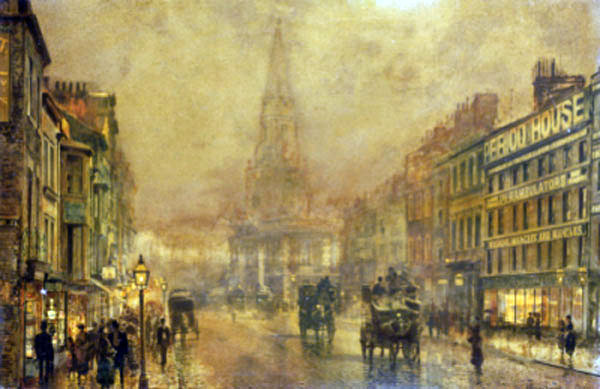

Blackman Street is only 100 yards or so from Little Surrey Street where Eliza's aunt Catherine Partleton (1810-1895) was living in 1850. Catherine emigrated to America in that year.
Ok, what else is there? London just seems to be crawling with interest in Victorian times. Everywhere you look, something is happening. Usually something dreadful. If you scroll back up to the map, you'll see the Surrey County Gaol [Jail] circled in red. It's on Union Road, formerly Horsemonger Lane.

If Eliza was bored on a Sunday, for entertainment she could go to the County Jail - about 1 minute walk from her house - to watch a public execution.
As we can see above, there was a gibbet over the main gate of the prison where the condemned were hanged on Sundays in front of large crowds. These spectacles continued until 1874.
On November 13 1849, just 18 months before we see Eliza in the 1851 census, probably the most celebrated hanging to be carried out at Horsemonger Lane occurred. The case involved a love triangle in which husband and wife Frederick and Maria Manning were found guilty of murdering Maria's lover Patrick O'Connor having first invited him round for dinner, and then burying him under the kitchen floor. The motive was to get their hands on Patrick's money.

They were found guilty amongst much public scandal about their behaviour, especially regarding Mrs Manning's sexual impropriety. It is estimated that between 30,000 and 50,000 people came to see the hanging; it was equally popular with the upper classes as with the poor. Every available space was filled with spectators; over 500 police were on hand to marshal the crowd.
The satirical Magazine Punch made much play over the hypocrisy and levity of the crowd and the 'Great Moral Lesson' to be learned which we see in the cartoon below:
The Great Moral Lesson at Horsemonger Lane Gaol, Punch, November 1849:

The situation is wonderfully described by Charles Dickens who witnessed the event and subsequently wrote a letter to The Times on 13 November 1849:
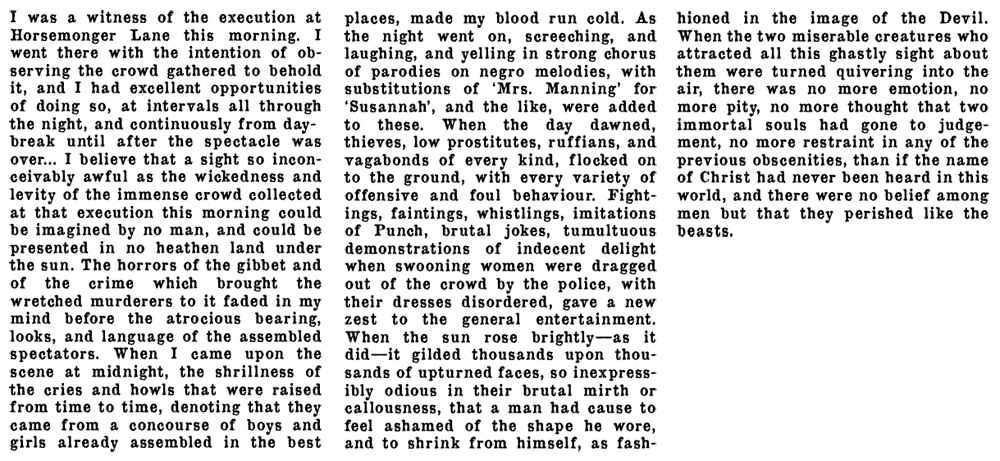
Charles Dickens to the Editor of The Times, Letters. Nov. 13, 1849
Clearly, living in the neighbourhood, Eliza must have been aware of all this fuss.
Southwark is not always the most wholesome of areas; another landmark is the Queen's Bench Prison, circled in yellow on the map. This is a debtor's prison, a contradictory place which is rather puzzling to our modern sensibilities.

In the picture above, it doesn't look much like a prison. But look closer... you'll see the high walls and spikes. If you are an inmate here, you have to pay rent. There are rooms of all types. You can have a small room to yourself for a shilling a week but you'll have to provide your own furniture. If you can't afford that, you can share the same room with two other persons for 4d a week. Some of the inmates are living in this prison in extremely comfortable circumstances in luxurious rooms at high rents. For the wealthier residents, it's an open prison & they are allowed out into the nearby streets during the day.
But how were you expected to pay your debts if you were locked up? Good question, & I suppose some of the inmates had independent means or were able to sell some of their assets to pay their way out.
Anyhoo, we must get back to our Eliza. She's not in prison, though she would be very familiar with the above view. The next we see of her is her marriage in the October quarter of 1854:

In the above index we see that Eliza and her big brother William George Partleton, who were christened on the same day, are married within a few weeks of each other and are listed together on the index.
Eliza's new husband is John Thompson, whose unusual middle name of Bowerbank (from his mother's maiden name) is a great help to the family historian who is trying to identify him.

John Bowerbank Thompson was born in Cumberland, a county which puts us on alert... perhaps here's a clue to the link between the London and Cumberland Partleton names? [Note: we also have a Tom Thompson Partleton (b1865)]. Is there some connection?
The answer appears to be 'probably no connection'. The village of Skelton is nowhere near to Workington or Whitehaven, the places where we always find the Cumberland Partletons.
John seems to have made his way to London on his own. In 1851 at the age of 28 - when Eliza is living south of the river in Southwark - we find John living and working at the premises of Mr Howland Hooper, a draper, of 52 Oxford Street, London. For anyone reading this who is not from Britain, I will explain that Oxford Street is London's main shopping thoroughfare, and a draper sells cloth:

Here where the the draper's shop is, at 52 Oxford Street, marked by the yellow arrow:

Here's a whole stretch of Oxford Street:
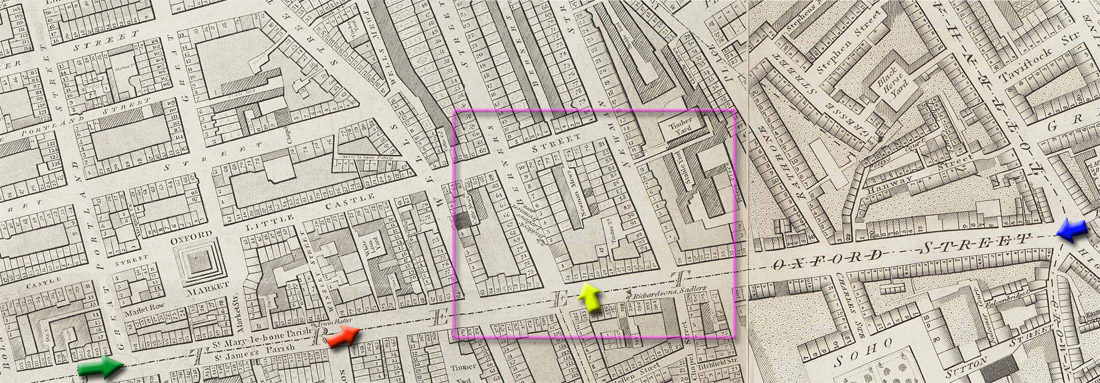
In the photo below, we look from the viewpoint of the red arrow (beside no. 74 Oxford St.) and see the location of the draper's shop (yellow arrow):

There are some really nice pictures of Victorian Oxford Street to be found on the internet:
Looking west from Tottenham Court Road (blue arrow on map):
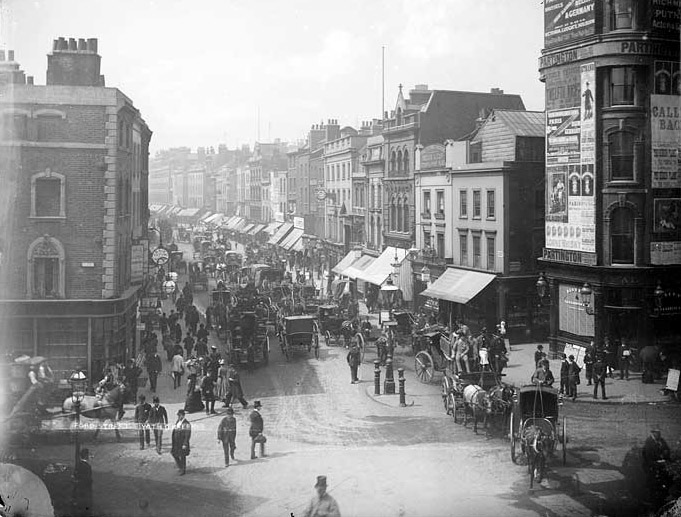
Looking East. The junction with Great Portland Street is on the left (viewpoint of green arrow on map), and the same corner shop, 100 & 101 Oxford St, as it had been in 1830:

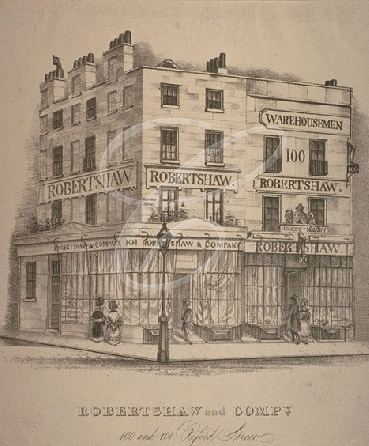
Some more general views of bustling Oxford Street:



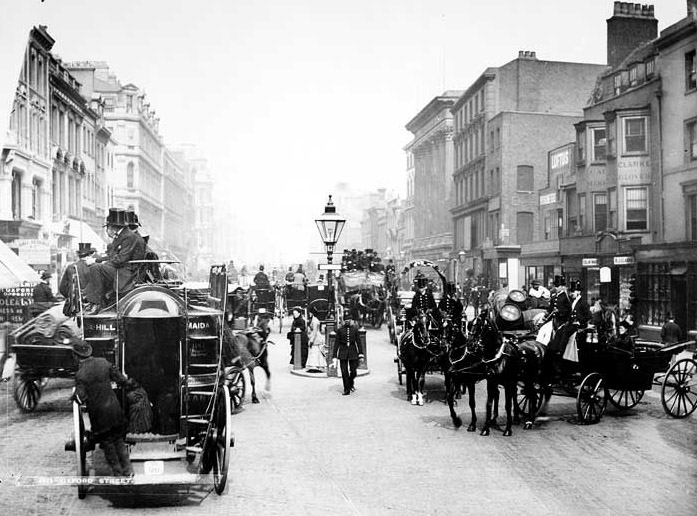
The draper's shop, no 52 Oxford Street, is presently a branch of HSBC Bank.
We seem to have left Eliza Catherine Partleton far behind, so let's remind ourselves that she married Cumbrian John Bowerbank Thompson in 1854. How she met John, we'll surely never know... they are both in the rag trade... perhaps there's a connection.
So, let's go in search of Eliza in the 1861 census:
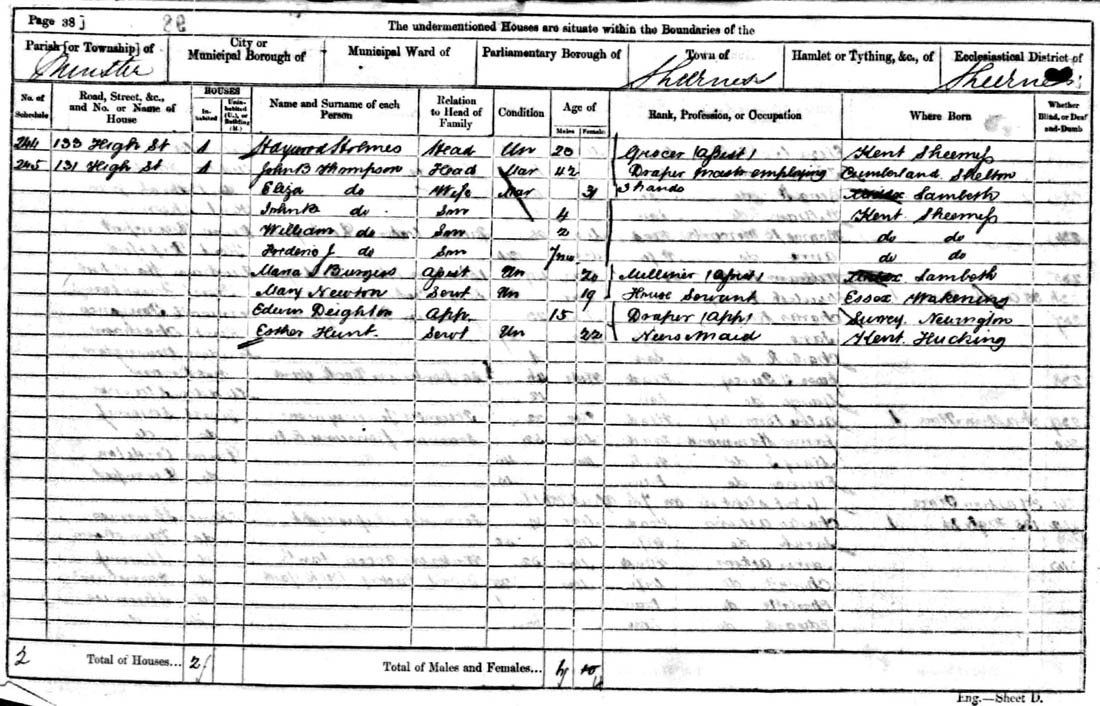
It's been possible to track Eliza through all these censuses thanks to the amazing records held by Ancestry.co.uk. If you're inspired by this website to seek out your own British ancestors as I have done, click here.
So, in 1861, seven years after her marriage, Eliza is in Sheerness on the Isle of Sheppey:
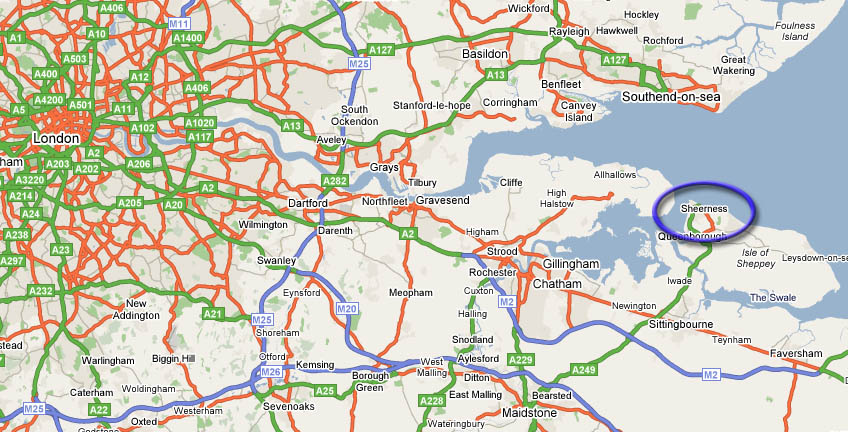
John and Eliza have their own draper's shop at 131 High Street, Sheerness. It seems that John Bowerbank Thompson is a bit of an entrepreneur. He has left the shop on Oxford street and set up his own business: Draper Master Employing 3 hands.
Step into Eliza's shoes as she steps out of her shop on to Sheerness High Street:


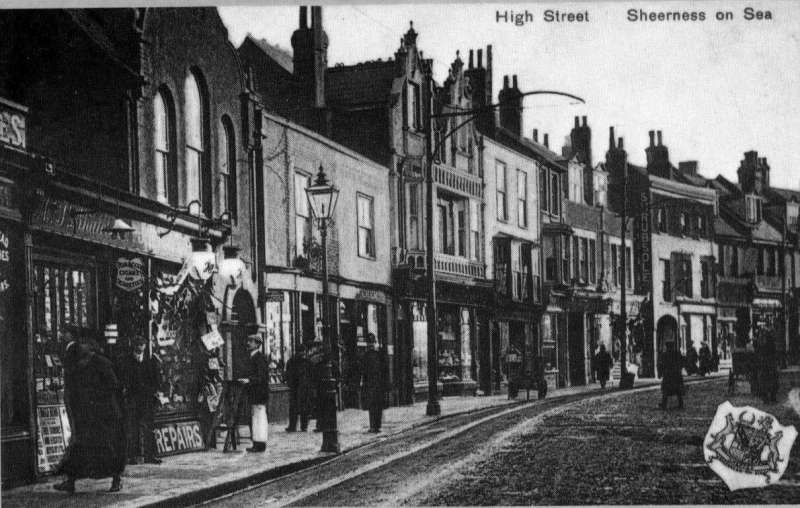

It's not a big place; the above four views, though separated in time, are almost identical. The liquor store, 'Shrubsole' is visible in three of the four pictures. I believe Eliza's shop is out of vision just around the bend to the right.
From the census sheet we can see that John and Eliza have three children;
John B Thompson (b1857)
William Thompson (b1859)
Frederick J Thompson (b1860)
And we can also note that they can afford a servant, Esther Hunt, as a nursemaid for the babies.
In 1871 we see Eliza has another boy; Arthur W Thompson, born 1865, and the Thompsons have a couple of servants:
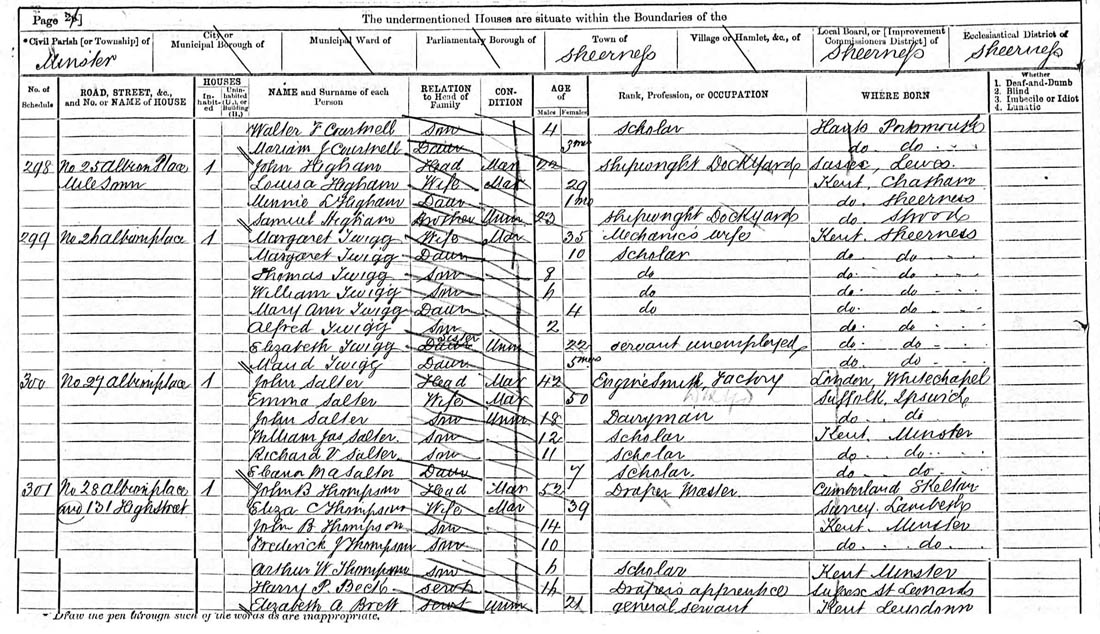
We note that 131 High Street is also known as 28 Albion Place, which enables us to pinpoint its location exactly:


By 1881 all the children have left home. John is now 'Draper Master Employing 1 man and 1 boy'
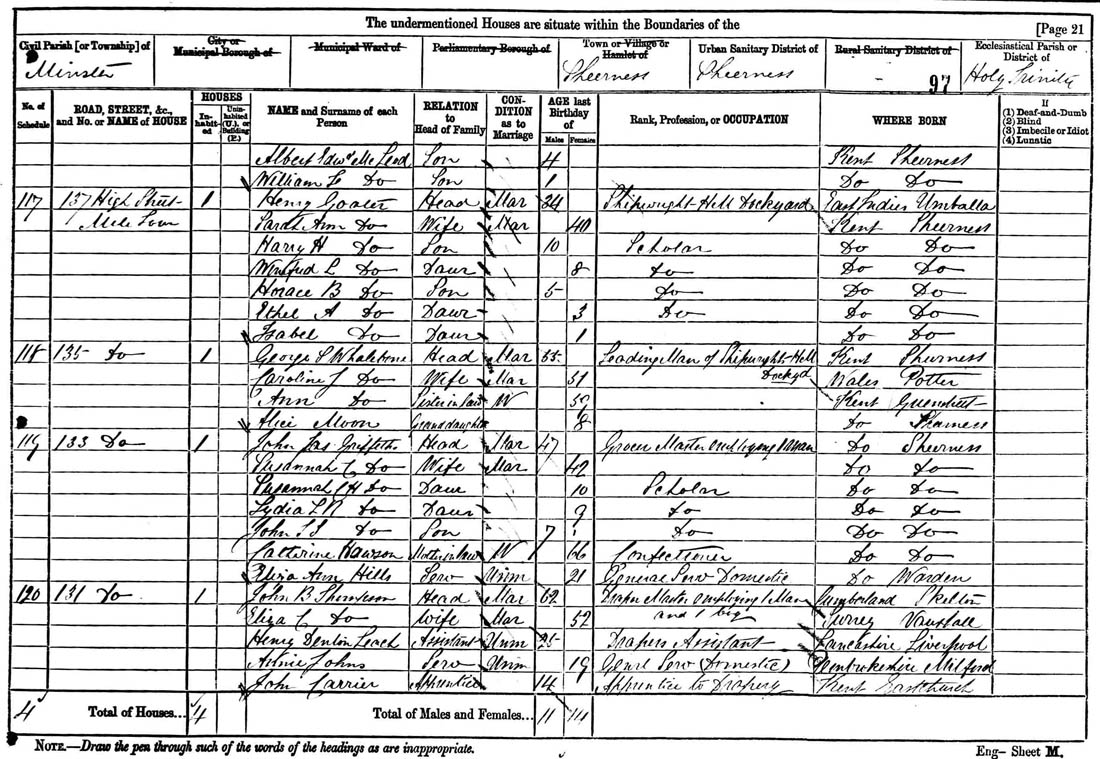
So we move on to 1891 and we find that John Bowerby Thompson has died (1885), leaving Eliza a widow.

Eliza has moved back to London and is running a draper's shop on The Ridgway, Wimbledon with her son Frederick. I looked for The Ridgway and found this photo of the 1950s...
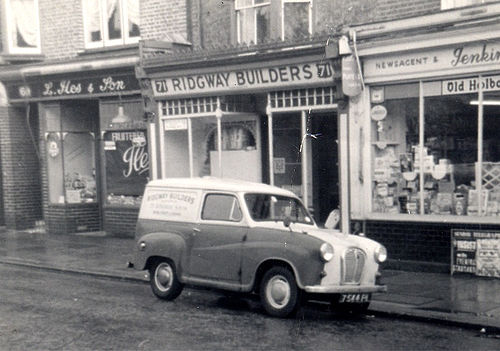
Here's the same three shops today (2009). Thomas Jenkins, who established his little newsagent shop (on the right of the picture) before 1860, must be pleasantly surprised that it's still there today, bearing his name:

And the next shop along, picked out by the red arrow - that was Eliza's drapers shop!
Here's a closer look:

The owner of this restaurant has combined Eliza's shop with the one next door. Eliza's house is No 75 - the left half of the 'Light House' which we see above.
Let's have another look at that 1891 census:

Also in view in the census (circled in green) is the King of Denmark pub:

The King of Denmark which was present in Eliza's day was demolished in 1936 and replaced with the pub which we see above. Eliza's shop is visible at the end of the row. As we can see, the King of Denmark is now closed and slated for demolition - again - and is the subject of a planning battle for its redevelopment opposed by Wimbledon residents (in 2007).
Back to Eliza again in 1901:
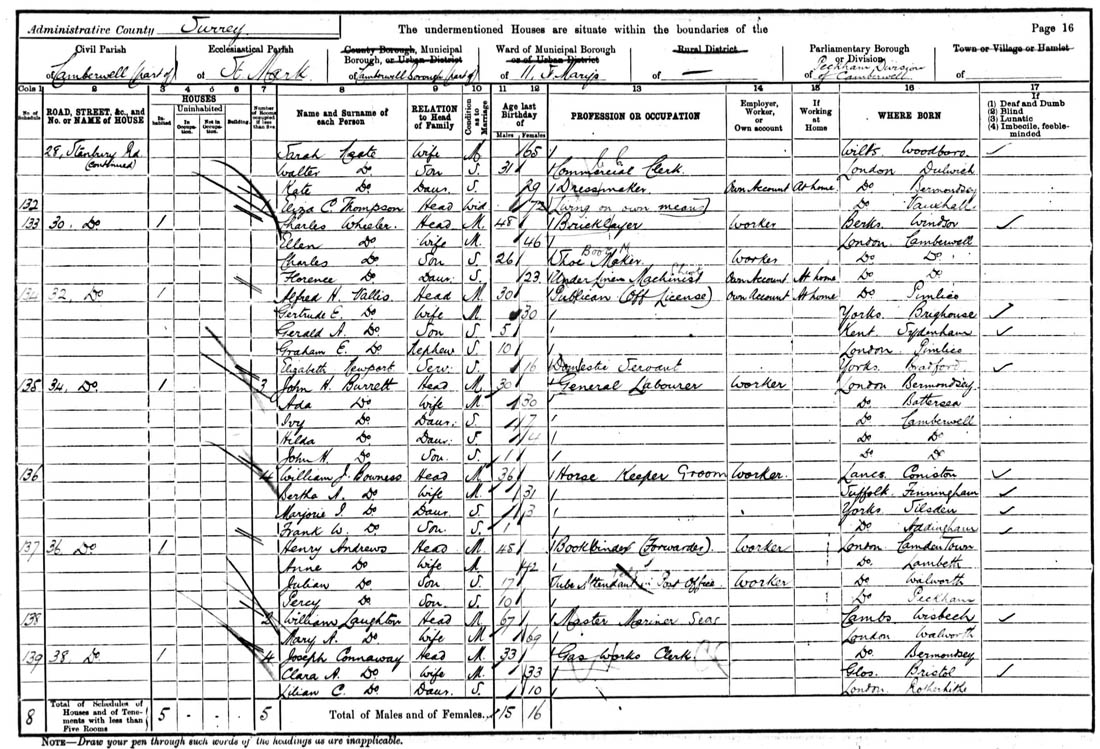
Eliza has not surprisingly retired. She's living on her own means, so let's hope she has saved some money for her retirement, renting a room at 28 Stanbury Road which is in Camberwell / Peckham.
Eliza's brother William George Partleton is also living in Camberwell during the last year of his life in 1898, so we can guess they were in touch. Maybe he stayed with Eliza. Eliza Catherine Partleton finally passed away, aged 78, in Camberwell, in the January quarter of 1908.
If you enjoyed reading this page, you are invited to 'Like' us on Facebook. Or click on the Twitter button and follow us, and we'll let you know whenever a new page is added to the Partleton Tree:
Click here to return to the Partleton Tree 'In Their Shoes' Page.